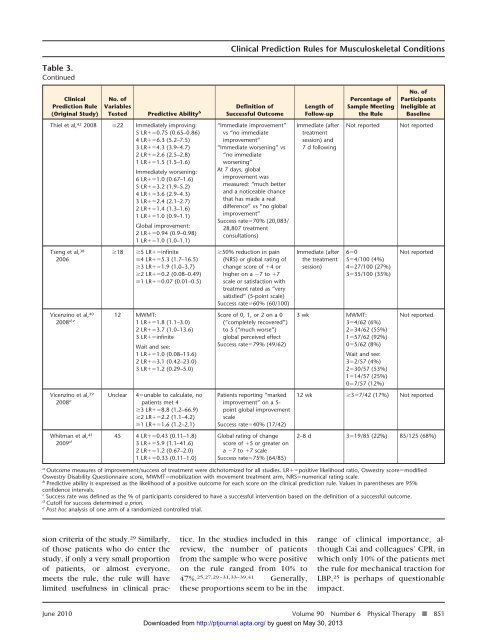Critical Appraisal of Clinical Prediction Rules That Aim to Optimize ...
Critical Appraisal of Clinical Prediction Rules That Aim to Optimize ...
Critical Appraisal of Clinical Prediction Rules That Aim to Optimize ...
Create successful ePaper yourself
Turn your PDF publications into a flip-book with our unique Google optimized e-Paper software.
Table 3.<br />
Continued<br />
<strong>Clinical</strong><br />
<strong>Prediction</strong> Rule<br />
(Original Study)<br />
No. <strong>of</strong><br />
Variables<br />
Tested Predictive Ability b<br />
Thiel et al, 42 2008 22 Immediately improving:<br />
5LR0.75 (0.65–0.86)<br />
4LR6.3 (5.2–7.5)<br />
3LR4.3 (3.9–4.7)<br />
2LR2.6 (2.5–2.8)<br />
1LR1.5 (1.5–1.6)<br />
Immediately worsening:<br />
6LR1.0 (0.67–1.6)<br />
5LR3.2 (1.9–5.2)<br />
4LR3.6 (2.9–4.3)<br />
3LR2.4 (2.1–2.7)<br />
2LR1.4 (1.3–1.6)<br />
1LR1.0 (0.9–1.1)<br />
Global improvement:<br />
2LR0.94 (0.9–0.98)<br />
1LR1.0 (1.0–1.1)<br />
Tseng et al, 38<br />
2006<br />
Vicenzino et al, 40<br />
2008 d,e<br />
Vicenzino et al, 39<br />
2008 e<br />
Whitman et al, 41<br />
2009 d<br />
18 5 LRinfinite<br />
4 LR5.3 (1.7–16.5)<br />
3 LR1.9 (1.0–3.7)<br />
2 LR0.2 (0.08–0.49)<br />
1 LR0.07 (0.01–0.5)<br />
12 MWMT:<br />
1LR1.8 (1.1–3.0)<br />
2LR3.7 (1.0–13.6)<br />
3LRinfinite<br />
Wait and see:<br />
1LR1.0 (0.08–13.6)<br />
2LR3.1 (0.42–23.0)<br />
3LR1.2 (0.29–5.0)<br />
Unclear 4unable <strong>to</strong> calculate, no<br />
patients met 4<br />
3 LR8.8 (1.2–66.9)<br />
2 LR2.2 (1.1–4.2)<br />
1 LR1.6 (1.2–2.1)<br />
45 4 LR0.43 (0.11–1.8)<br />
3LR5.9 (1.1–41.6)<br />
2LR1.2 (0.67–2.0)<br />
1LR0.33 (0.11–1.0)<br />
sion criteria <strong>of</strong> the study. 29 Similarly,<br />
<strong>of</strong> those patients who do enter the<br />
study, if only a very small proportion<br />
<strong>of</strong> patients, or almost everyone,<br />
meets the rule, the rule will have<br />
limited usefulness in clinical prac-<br />
Definition <strong>of</strong><br />
Successful Outcome<br />
“Immediate improvement”<br />
vs “no immediate<br />
improvement”<br />
“Immediate worsening” vs<br />
“no immediate<br />
worsening”<br />
At 7 days, global<br />
improvement was<br />
measured: “much better<br />
and a noticeable chance<br />
that has made a real<br />
difference” vs “no global<br />
improvement”<br />
Success rate70% (20,083/<br />
28,807 treatment<br />
consultations)<br />
50% reduction in pain<br />
(NRS) or global rating <strong>of</strong><br />
change score <strong>of</strong> 4 or<br />
higher on a 7 <strong>to</strong>7<br />
scale or satisfaction with<br />
treatment rated as “very<br />
satisfied” (5-point scale)<br />
Success rate60% (60/100)<br />
Score <strong>of</strong> 0, 1, or 2 on a 0<br />
(“completely recovered”)<br />
<strong>to</strong> 5 (“much worse”)<br />
global perceived effect<br />
Success rate79% (49/62)<br />
Patients reporting “marked<br />
improvement” on a 5point<br />
global improvement<br />
scale<br />
Success rate40% (17/42)<br />
Global rating <strong>of</strong> change<br />
score <strong>of</strong> 5 or greater on<br />
a 7 <strong>to</strong>7 scale<br />
Success rate75% (64/85)<br />
tice. In the studies included in this<br />
review, the number <strong>of</strong> patients<br />
from the sample who were positive<br />
on the rule ranged from 10% <strong>to</strong><br />
47%. 25,27,29–31,33–39,41 Generally,<br />
these proportions seem <strong>to</strong> be in the<br />
Length <strong>of</strong><br />
Follow-up<br />
Immediate (after<br />
treatment<br />
session) and<br />
7 d following<br />
Immediate (after<br />
the treatment<br />
session)<br />
Percentage <strong>of</strong><br />
Sample Meeting<br />
the Rule<br />
No. <strong>of</strong><br />
Participants<br />
Ineligible at<br />
Baseline<br />
Not reported Not reported<br />
60<br />
54/100 (4%)<br />
427/100 (27%)<br />
335/100 (35%)<br />
3 wk MWMT:<br />
34/62 (6%)<br />
234/62 (55%)<br />
157/62 (92%)<br />
05/62 (8%)<br />
Wait and see:<br />
32/57 (4%)<br />
230/57 (53%)<br />
114/57 (25%)<br />
07/57 (12%)<br />
Not reported<br />
Not reported<br />
12 wk 37/42 (17%) Not reported<br />
2–8 d 319/85 (22%) 85/125 (68%)<br />
a Outcome measures <strong>of</strong> improvement/success <strong>of</strong> treatment were dicho<strong>to</strong>mized for all studies. LRpositive likelihood ratio, Oswestry scoremodified<br />
Oswestry Disability Questionnaire score, MWMTmobilization with movement treatment arm, NRSnumerical rating scale.<br />
b Predictive ability is expressed as the likelihood <strong>of</strong> a positive outcome for each score on the clinical prediction rule. Values in parentheses are 95%<br />
confidence intervals.<br />
c Success rate was defined as the % <strong>of</strong> participants considered <strong>to</strong> have a successful intervention based on the definition <strong>of</strong> a successful outcome.<br />
d Cut<strong>of</strong>f for success determined a priori.<br />
e Post hoc analysis <strong>of</strong> one arm <strong>of</strong> a randomized controlled trial.<br />
<strong>Clinical</strong> <strong>Prediction</strong> <strong>Rules</strong> for Musculoskeletal Conditions<br />
range <strong>of</strong> clinical importance, although<br />
Cai and colleagues’ CPR, in<br />
which only 10% <strong>of</strong> the patients met<br />
the rule for mechanical traction for<br />
LBP, 25 is perhaps <strong>of</strong> questionable<br />
impact.<br />
June 2010 Volume 90 Number 6 Physical Therapy f 851<br />
Downloaded from<br />
http://ptjournal.apta.org/ by guest on May 30, 2013
















